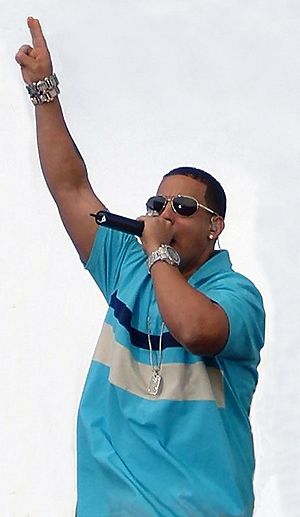Reggaeton facts for kids

Reggaeton is a form of urban music that first became popular with Latin American youths in the early 1990s. Reggaeton's predecessor originated in Panama as Reggae en Español. After the music's gradual exposure in Puerto Rico, it eventually evolved into reggaeton. It blends British West reggae and dancehall with Latin American genres, as well as hip hop. Modern reggaeton beats follow the structure of the Dem Bow Riddim, a beat created by Jamaican producers Steely & Clevie in the late 80s and early 90s. However, over the years, it has been losing every noticeable similarity with its original reggae origins.
Etymology
The word reggaeton (formed from the word reggae plus the augmentative suffix -tón) was first used in 1988, when El General's representative Michael Ellis gave it that name to describe it as "reggae grande" (big reggae). The spellings reggaeton and reggaetón are common, although prescriptivist sources such as the Fundéu BBVA and the Academia Puertorriqueña de la Lengua Española recommend the spelling reguetón, as it conforms more closely with traditional Spanish spelling rules.
History
Often mistaken for reggae or reggae en Español, reggaeton is a younger genre that originated in the late-1980s in Panama and since then has become popularized by Puerto Rican artists. It had its origins in what was known as Rap y reggae "underground" music, due to its circulation through informal networks and performances at unofficial venues. DJ Playero and DJ Nelson were inspired by hip hop and Dancehall to produce "riddims", the first reggaeton tracks. As Caribbean and African-American music gained momentum in Puerto Rico, reggae rap in Spanish marked the beginning of the Boricua underground and was a creative outlet for many young people. This created an inconspicuous-yet-prominent underground youth culture which sought to express itself. As a youth culture existing on the fringes of society and the law, it has often been criticized. The Puerto Rican police launched a campaign against underground music by confiscating cassette tapes from music stores under penal obscenity codes, levying fines and demonizing rappers in the media. Bootleg recordings and word of mouth became the primary means of distribution for this music until 1998, when it coalesced into modern reggaeton. The genre's popularity increased when it was discovered by international audiences during the early 2000s.
Characteristics
Rhythm
The dembow riddim was created by Jamaican dancehall producers during the late 1980s and early 1990s. Dembow consists of a kick drum, kickdown drum, palito, snare drum, timbal, timballroll and (sometimes) a high-hat cymbal. Dembow's percussion pattern was influenced by dancehall and other West Indian music (soca, calypso and cadence); this gives dembow a pan-Caribbean flavor. Steely & Clevie, creators of the Poco Man Jam riddim, are usually credited with the creation of dembow. At its heart is the 3+3+2 (tresillo) rhythm, complemented by a bass drum in 4/4 time.
The riddim was first highlighted by Shabba Ranks in "Dem Bow", from his 1991 album Just Reality. To this day, elements of the song's accompaniment track are found in over 80% of all reggaeton productions. During the mid-1980s, dancehall music was revolutionized by the electronic keyboard and drum machine; subsequently, many dancehall producers used them to create different dancehall riddims. Dembow's role in reggaeton is a basic building block, a skeletal sketch in percussion.
In Reggaeton 'dembow' also incorporates identical Jamaican riddims such as Bam Bam, Hot This Year, Poco Man Jam, Fever Pitch, Red Alert, Trailer Reloaded and Big Up riddims, and several samples are often used. Some reggaeton hits incorporate a lighter, electrified version of the riddim. Examples are "Pa' Que la Pases Bien" and "Quiero Bailar", which uses the Liquid riddim.
Since 2018 a new variation of the Dembow rhythm has emerged; Starting with Te Bote, a sharper minimalist Dembow has become a stable of Reggaeton production which has allowed for more syncopated rhythmic experiments.
Lyrics and themes
Reggaeton lyrical structure resembles that of hip hop. Although most reggaeton artists recite their lyrics rapping (or resembling rapping) rather than singing, many alternate rapping and singing. Reggaeton uses traditional verse-chorus-bridge hip hop structure. Like hip hop, reggaeton songs have a hook which is repeated throughout the song. Latino ethnic identity is a common musical, lyrical and visual theme.
Images for kids
-
J Balvin in 2017
See also
 In Spanish: Reguetón para niños
In Spanish: Reguetón para niños




